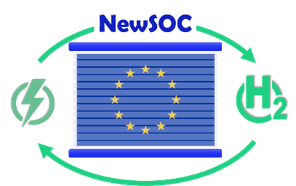

Developing novel electrodes for robust Solid Oxide Cells
06-03-2020 | New Project | P2Hydrogen
 VoltaChem researchers at TNO have recently started the development of novel oxygen electrodes for a new generation of robust Solid Oxide Cells at the Faraday Lab in Petten, one of the hydrogen research facilities that VoltaChem has in use. This research is part of the three year, 5 million euro 'NewSOC' project that started in January 2020, funded by the Fuel Cells and Hydrogen Joint Undertaking.
VoltaChem researchers at TNO have recently started the development of novel oxygen electrodes for a new generation of robust Solid Oxide Cells at the Faraday Lab in Petten, one of the hydrogen research facilities that VoltaChem has in use. This research is part of the three year, 5 million euro 'NewSOC' project that started in January 2020, funded by the Fuel Cells and Hydrogen Joint Undertaking.
The NewSOC project aims at significantly improving performance, durability, and cost competitiveness of solid oxide cells & stacks compared to the current state-of-the-art technology. It involves the research and development of twelve novel SOC (Solid Oxide Cell) concepts based on existing as well as improved, alternative materials. NewSOC also focuses on innovative manufacturing technology to reduce critical raw materials usage and lower the environmental footprint, at improved performance & lifetime.
The project involves 16 partners from academia and industry that in a joint effort will realise and validate new cells & stacks at the level of large cells with > 50 cm2 active area, moving the technology readiness level (TRL) from 2 to 4. Six major European SOC manufacturers are part of the consortium, representing a large range of SOC concepts and product & market strategies. The industry partners will take the lead beyond the project period in increasing the TRL level towards 6.
Further develop SOC potential
Within the VoltaChem program line Power-2-Hydrogen, Solid Oxide Cell technology is an important area of expertise that contributes to the mission to develop low-cost manufacturing of electrolyzers and components in order to accelerate industrial electrification. VoltaChem and TNO researchers are now able to produce Solid Oxide Electrolysis Cells at a size of 20x20 cm2 at the Faraday Lab in Petten, and are working with industrial partners to further develop the potential of this technology for cost-efficient water electrolysis, co-electrolysis and reversible electrolysis/fuel cell operation.
As part of the international NewSOC project, perovskite-based cobalt-free oxygen electrodes will be developed, as well as their manufacturing procedure. Cobalt is considered a critical raw material and the development of Co-free electrodes contributes to an SOEC technology that is - as much as possible - free of critical raw materials. The challenge in the current development is to bring the electrocatalytic activity of the Co-free oxygen electrode to the same level as the state-of-the-art Co-containing oxygen electrode, by optimisation of the electrode micro-structure. The optimized Co-free oxygen electrode will be scaled-up to at least 10x10 cm2 of solid oxide cell area. The resulting performance will be demonstrated under different modes of operation, such as co-electrolysis (simultaneous reduction of steam and CO2 to H2 and CO) and reversible electrolysis/fuel cell operation.
Are you interested in co-electrolysis technology or the development of associated materials?
Then join our VoltaChem community-of-practice Power-2-Hydrogen, or participate in one of our technology development projects. For that you can always contact our business development manager Lennart van der Burg of Power-2-Hydrogen.
This project has received funding from the Fuel Cells and Hydrogen 2 Joint Undertaking under grant agreement N. 874577. This Joint Undertaking receives support from the European Union’s Horizon 2020 research and innovation programme, Hydrogen Europe and Hydrogen Europe research.

Share this page: